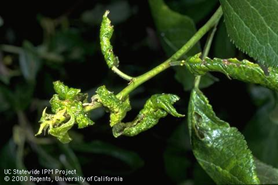Adapted from the article “A new season – When to begin irrigating and how much water to apply?” by Richard P. Buchner & Allan E. Fulton, UCCE Farm Advisors, Tehama County in the April 2011 Sacramento Valley Prune News
Growth of tender leaf tissue also signals the beginning of aphid season, especially if a fall or dormant aphid treatment was not applied. Two species of aphids overwinter as eggs on prunes and colonize prune trees in the spring. The first is leaf curl plum aphid (LCPA), which can be identified by its shiny green or yellow body. The second is mealy plum aphid (MPA), which is whitish or light green with three longitudinal dark green stripes and covered with a waxy coating.

Mealy plum aphid damage.

Leaf curl plum aphid damage.
Both aphids can cause damage to prune trees, however damage differs depending upon the species. LCPA feeding causes prune leaves to twist tightly around their bodies, which protects the aphid while it feeds on the main vein of the leaf. MPA feed on the underside of leaves, causing cupping of the leaf, and dripping honeydew onto lower leaves and fruit, leading to a black fungal growth or “sooty mold”.
The basic lifecycle of both species is similar. Aphids overwinter as eggs laid between shoots and dormant buds and are relatively difficult to find. At bud break, eggs hatch and aphids can multiply very rapidly for several generations, feeding on the tender leaf tissue. In late spring, aphids develop winged adults and migrate to an alternate summer host. This migration signifies the end of LCPA colonization until fall, when aphids migrate back to prune to lay eggs for the winter. Most mealy plum aphids will also migrate to an alternate host; however, a few remain behind and feed in orchards all summer long. Extensive feeding throughout the summer by MPA can lead to reduced fruit sugar levels and may be implicated in fruit cracking.
Monitoring. Orchards that did not have a dormant spray application should be scouted weekly beginning at petal fall and ending in mid-July to determine if a treatment is necessary (orchards that received a dormant application may choose to scout less frequently). Focus scouting in areas that are most likely to maintain higher aphid populations, such as near the perimeters or windbreaks or where aphids were found in previous years. Look for evidence of aphids: shiny sticky leaves may indicate aphids are feeding above; leaf twisting, cupping, or curling; or ants that may be feeding on aphid honeydew. If any signs of aphids are observed, examine the leaves more closely for the presence of live aphids.
Each week, check 40 trees for aphids. Each tree should take about 15 seconds to quickly check, or approximately 10 minutes to complete the scouting on all 40 trees. If greater than 10% of the leaves of a tree are infested with aphid colonies, the tree should be scored as having a “significant infestation”. The treatment threshold is 12 out of 40 trees with a “significant infestation” of either species of aphid. A more detailed description of monitoring, as well as treatment guidelines (if treatment is necessary), can be found at the UC IPM website.
Control. Effective control of either or both plum aphids is possible with several insecticides. Provado®, Actara®, and Asana® each gave excellent, in-season mealy plum aphid control in UC field research. Diazinon is a very effective aphid material and growers have used it successfully for aphid control at low rates. A high rate of oil – 6 gallons/acre – reduces aphid populations, but does not give complete control.
Good spray coverage is essential for good plum aphid control. Every-other-row spraying for plum aphids is a waste of time and money. Contact pesticides such as pyrethroids (Asana, etc.) must reach aphids inside curled or distorted leaves to give good control. Provado®, Actara®, and other similar pesticides move locally into the leaf where the aphids are feeding and so don’t require perfect spray coverage to give excellent control.
Help avoid pesticide resistance in aphids by alternating between pesticide chemistry groups every time you spray. Provado, Actara, and Assail are all the same class of insecticide – neonicitinoids (Group 4A insecticides). BeLeaf is in Group 9C. Diazinon is in group 1B. Pyrethroids (Asana, Warrior, Mustrang, etc.) are all in Group 3.
Use of Actara®, Provado®, and Asana® may contribute to increased spider mite populations later in the season. Consult with your packer regarding pesticide residue requirements for certain markets. Consult with your PCA for insecticide selection, rates, and timings.


Leave a Reply